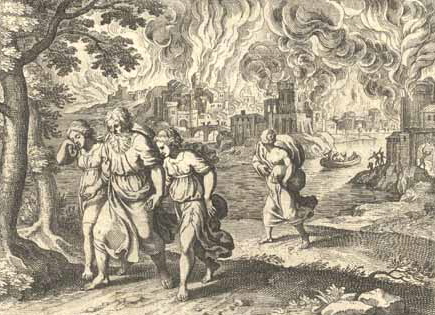
March 14, 2017, by Harry Cocks
Visions of Sodom: Religion and Sexuality since the Reformation
In September 1850, the French savant Louis-Felicien de Saulcy, charged with a Mission Scientifique from the French government, and in the company of a Catholic priest and four young men on a tour of the East, set out to circumnavigate and map the Dead Sea. Four months later, on his way round the shores of that lake, de Saulcy passed through what he described as a “huge mass of disconnected ruins” on its south western side, at a place called Kharbet-Esdoum ( the “Ruins of Sodom” according to de Saulcy’s translation), some of which looked “as if they had been burnt.” By reconciling scriptural accounts with those provided by classical authors, and considering the Arabic names of places on the Dead Sea shore, de Saulcy rapidly convinced himself and many others that he had found the remains of the biblical city of Sodom. For a brief moment, de Saulcy’s “discovery” electrified Europe and seemed to prove the veracity of the bible as a historical document. Soon, however, serious objections had been made, and the lack any archaeological evidence, as well as what was taken for his distinctively French credulity, undermined his claim. Sodom retreated again into sublime obscurity. De Saulcy’s expedition was, however, only one of many attempts to uncover the secrets of Sodom and Gomorrah.
According to Genesis 19:24, God had destroyed the cities “and all the plains, and all the inhabitants of the cities, and that which grew upon the ground.” (The flight of Lot and his daughters from that scene, and the petrification of his unfortunate lingering wife is depicted, right, by Matteus Merian, c 1630). The Sodomites’ crimes are variously described in scripture as the attempt to “know” Lot’s angelic visitors (Genesis 19:5), “going after strange flesh” (Jude 1:7), as well as “pride, fullness of bread, abundance of idleness” and neglect of the poor and needy (Ezekiel 16:49). By the sixteenth century though, the sins of the Sodomites had narrowed to the different species of fornication which they were assumed to be foisting on the angels, of which homoerotic desire was one key component. In my new book, Visions of Sodom (see link), I examine the different ways in which the Sodom story was read by Protestants in the three centuries after the Reformation. Sodom was not only representative of fornication in all its forms, but was also the epitome of false (usually Roman Catholic) religion, an exemplar of the iniquitous city, a foreshadowing of the world’s fiery demise, an embodiment of divine and earthly punishment, and an actual place that could be searched for and discovered. Fornication and sodomy had an easily explicable history and genealogy that could be traced to the original Cities of the Plain and used to explain all the “acts of uncleanness” as the legacy of the original Sodomites and their descendants. The centrality of scripture to Protestant faith (and therefore to English and British national identity) in the centuries after the Reformation meant that Sodom’s demise provided a powerful origin myth of homoerotic desires and sexual excess, one that persisted across centuries, up to and beyond de Saulcy’s quest. The idea that the descendants of the original Sodom might cause social breakdown or presage the end of the world even retains an apocalyptic echo in our own day.
Visions of Sodom: Religion, Homoerotic Desire, and the End of the World in England, c. 1550-1850 (University of Chicago Press, 2017)
http://press.uchicago.edu/ucp/books/book/chicago/V/bo25468953.html
No comments yet, fill out a comment to be the first

Leave a Reply